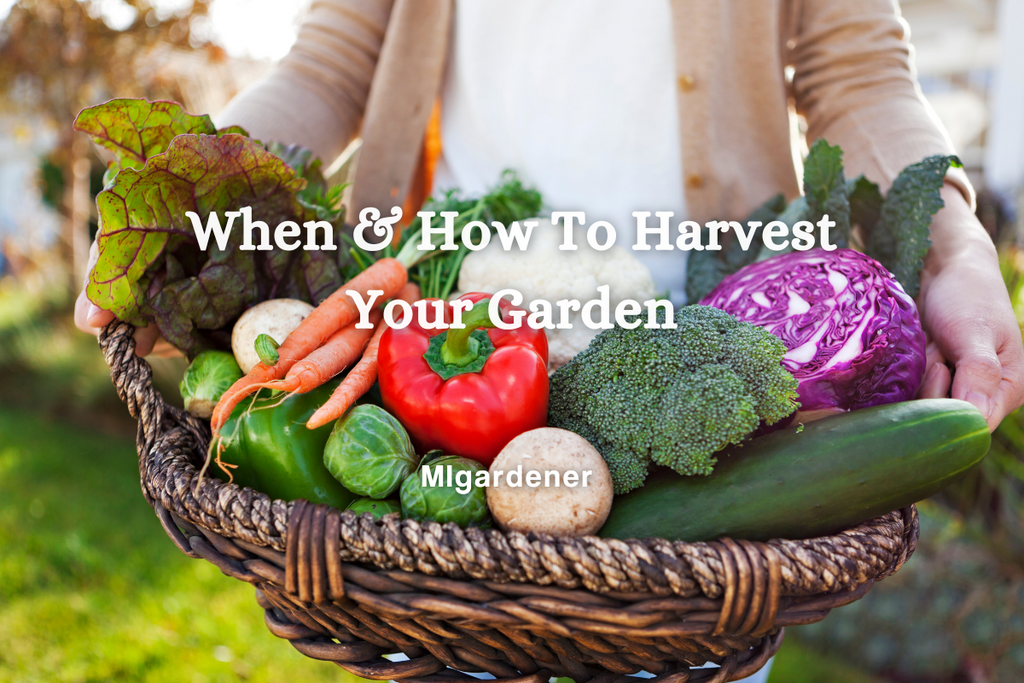
When & How To Harvest Your Harvest
The best quality vegetables are harvested at exactly the right time. There are a few tips and tricks to use, depending on what you are planting. Here's how to get the best flavor possible out of your harvest!
Let's get started!
Roots

The first step is to check shoulder growth with any root variety (beets, radishes, carrots, etc.). Once the shoulders get to a size you know is normal for each variety, they are good to harvest. Be aware that beets left in the hot weather for too long will become woody in texture. Carrots, parsnips, and rutabagas will sweeten the longer they are left in the ground. Parsnips are best if left in the ground all winter long. Remember to mulch any varieties you choose to leave that long.
Cucurbits

Vining vegetables are notorious for maturing extremely quickly. Once you spot zucchini and cucumbers growing on the vine, check on them daily until they get to the size they should be. Harvesting early when the fruits are small will result in tender fruits with the perfect texture and flavor. Leaving cucurbits on the vine for too long will result in tough skin, large seeds, and a stringy texture. With melons, their colors will change when they are ready to harvest. Muskmelons will turn from green to a cream color and start to smell sweet. You will know watermelons are ready to harvest when they have their white spots on the bottom turn deep yellow.
Brassicas

There are multiple varieties of Brassicas. Between broccoli, cauliflower, cabbage, and Brussels sprouts; keep an eye on their bud development. Don't expect your broccoli heads to grow as big as store-bought ones. Harvest these before flowers form to prevent bolting. With leafy brassicas like kale and mustard, young leaves will be more tender than older ones. However, if you want the leaves to grow bigger for any reason, massage them with oil to make them tender again before eating. Brassicas tend to mature best in the cooler growing seasons, so if they are maturing in the fall, for example, leaving them longer will make for a sweeter harvest.
Winter Squash

Winter squash need to go through the curing process before being ready for storage. Once pumpkins, Hubbards, acorn, etc., have reached their desired color, and you notice their vines start to wane, check the thickness of the skin. Poke the skin with your fingernail. Winter squash varieties are ready to harvest if you cannot poke through their skin. This method ensures decorative varieties will survive the frost if left outside.
Nightshades

Nightshades can be a surprising bunch. For example, I didn't know potatoes were related to tomatoes until gathering information for this blog post! While tomatoes, peppers, and eggplants are grown for their fruit, potatoes are planted for their roots! As you can imagine, harvesting these will vary depending on which ones you have in your garden.
Eggplants are probably the most finicky of the group. They have the best flavor and texture when harvested slightly immaturely. Remember to cut eggplants instead of pulling them to avoid harming the plant. Fresh potatoes are ready to harvest once the plant begins to flower, but for fully mature potatoes that will keep well, wait until the top of the plant is going brown and crispy. Tomatoes and peppers are slightly more intuitive. Harvest both when they are fully colored and slightly soft to the touch. Green peppers can be eaten at any point but will be sweeter if left for longer.
Legumes

Legumes are a family of plants that are grown for eating the fresh or dry seeds of a plant. Depending on the variety or your personal goal for growing, beans and peas are harvested at different times in the season, depending on their use. For legumes with delicious fruits like string beans and snap peas, harvest the young before the seeds bulk up, and the fruit becomes chewy and unpleasant. Beans or peas that you eat fresh out of the pod should be left on the plant longer until the pods are still soft. For storage, let the beans and peas grow and dry completely in their pods before shelling and saving. These homegrown dry goods will stay keep for 2-3 years. You can cook them after 10 years if need be, but their nutritional value may have depleted in that time slightly.
Seeds

Before there were any seed stores, harvesting and saving seeds was an essential practice passed down from generation to generation! Use these tutorials to learn how and when to harvest seeds:








Although I have been gardening and raising flowers for many years I have not had a vegetable garden and have no experience with seeds. I am happy to have found you and your post and information I believe will help me so much.
Centiflora I believe
I’ve been watching your channel for a while now. You have some great ideas. Back in October, I think, you did a video about cleaning up the garden for winter crops. You showed the last if some cherry tomatoes that had large clusters of tomatoes. I think they had an Italian name like “millaflora”. I can’t find them on your seed site. Do you remember what they are called?
Leave a comment